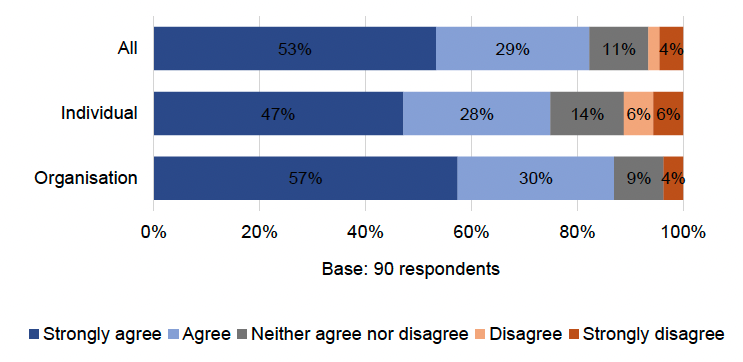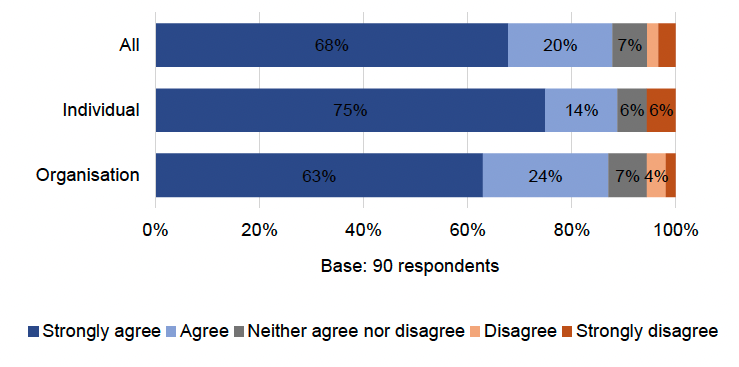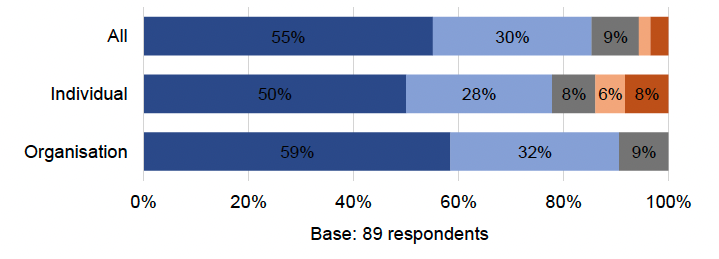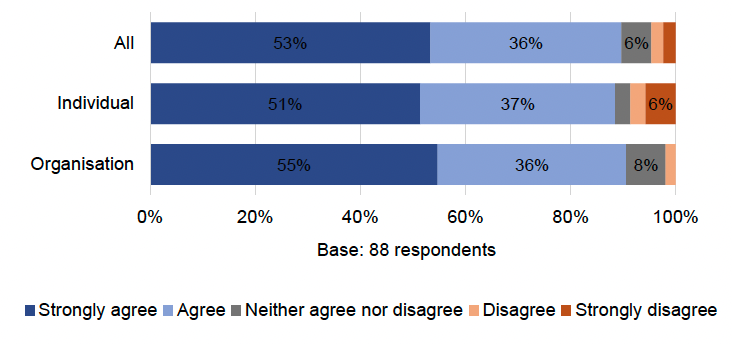Building regulations – compliance and enforcement: consultation analysis
Analysis of the building regulations compliance and enforcement consultation which ran between 11 November 2021 and 9 February 2022.
2. Creation of a New Compliance Plan Approach
2.1 Compliance Plan Manager (CPM) role
1. The majority of respondents (82%) agree with the CPM role as outlined in Annex B of the consultation document, on projects for all High Risk Buildings (HRBs). The strength of agreement is marginally stronger among organisations compared with individuals (Figure 2.1).

2. The most prominent reason for agreeing with the CPM role (mentioned by 39 respondents, including 29 organisations) is ensuring greater compliance with the building regulations, including better compliance in the case of HRBs.
"We agree with the role as a positive step towards compliance, ensuring building and fire safety standards are identified at an early stage in the construction process, and [that buildings are] constructed with evidence that standards have been met." – Organisation
3. A total of 13 respondents feel that the CPM role would lead to a marked improvement in safety for all building occupants; and improvements to the current construction and approval process.
"I strongly agree [with the CPM role] – to improve life safety, property protection and confidence in workmanship by increasing the likelihood of HRBs being constructed in line with building regulations and associated approved designs" – Individual
4. Additionally, nine respondents would like to see the CPM role have the authority to enforce compliance with the regulations. This, they feel, would lead to stronger improvements in the building process.
"I agree with the CPM role as detailed in Annex B on projects for all HRBs. With increased demands for eco-compatibility of buildings, the need to reduce energy expenditure and minimise the release of global warming pollutants, it is essential that the role should have both the impact and the authority to enforce improved behaviour on the part of building contractors." – Organisation
5. A small number of those agreeing (seven) raised the point about professional indemnity (PI) insurance and questioned how this would be put in place for the CPM, especially as this is often held by an employer rather than employee. Reference was made to problems for developers in England obtaining PI insurance following the Grenfell Tower fire, which would presumably need to be overcome for the CPM.
6. Seven respondents would like to see further detail about the role's competency, accountability and insurance requirements, noting that the CPM would need sufficient knowledge of the process to interrogate design choices and determine compliance.
"We strongly agree that a CPM should be required on projects for all HRBs… However, the effectiveness of the role will be dependent on the specifics [that would need to be set out] in a CPM Compliance Plan Handbook, CPM competences (including qualifications and experience) and CPM accountability (including professional indemnity cover requirements)." – Organisation
7. Among the minority of respondents neither agreeing nor disagreeing, three said that there appears to be overlap between the proposed CPM role and the current Clerk of Works role and that clarity would be needed on the differences between the two. These respondents would want to see a Handbook for the CPM in order to agree. One organisation expanded on this by saying that they understand the new role would introduce a "robust approach", but that further clarity would be needed on the interplay with existing responsibilities, such as design and construct safety under the Construction (Design and Management) Regulations 2015.
8. Of the small minority of respondents disagreeing with the CPM role, three (all individuals) believe the local authority building standards services should be funded to undertake more detailed inspection regimes and there were concerns that the CPM role might increase costs for developers. It is worth noting that this alternative approach could have resourcing implications for local authorities and a possible knock-on impact on building warrant/completion certificate fees.
"I disagree with the premise of the proposal. We need a properly funded building standards [operation] with a defined professional career path for Building Standards Officers. We need such professionals, without commercial interests from the private sector, acting in the public interest. This should be funded by warrant fees that reflect the work that needs doing." – Individual
2.2 Independence of CPM role from contractor
1. The vast majority of respondents (88%) agree that the CPM role should be independent of the contractor. The strength of agreement is marginally stronger among individuals compared with organisations (Figure 2.2).

2. A total of 73 respondents provided additional comments. Many (29, including 20 organisations) favour the independence of the CPM role for mitigating any possible conflict of interest. Otherwise, according to these respondents, there could be situations where a contractor chooses a particular CPM who might be most likely to "pass" the work; or where a CPM may want to protect their own employment by not "condemning" their own organisation's work.
"The importance of the role requires that it be independent of the contractor to ensure transparency and avoid any conflict of interest. The well-publicised issues of incidents with the approved inspector system in England and Wales should be avoided. [Independence] would also likely be required as part of any chartered membership of the CPM." – Organisation
3. A smaller number of respondents agreeing with the proposal, emphasised that the role should be coupled with greater efforts to improve the responsibility and processes of the developers, contractors and builders.
4. Several respondents mentioned the importance of clearly defining what is meant by 'independent' and emphasised that this should not detract from efforts to improve the responsibility and processes of the developers, contractors and builders themselves.
5. Four respondents believe the role would be best placed as a local authority or Government role to ensure a suitable level of separation between the contractor and the CPM.
6. Two respondents questioned whether the independent role may be difficult to recruit for or fund, especially given the need, in their view, for a high degree of competency to carry out the responsibilities effectively.
7. One organisation agrees in principle that the CPM should be independent of the contractor but feels that it might be possible for sufficient safeguards to be incorporated into the competences and accountabilities of a CPM that would allow a degree of connection with the contractor. This, it is felt, could increase the number of suitably qualified, competent persons, should such a need arise.
8. Six respondents neither agreeing nor disagreeing that the role should be independent of the contractor, asserted that the role could be reasonably carried out by members of the contracting team. Two said that as the Responsible Person is already legally responsible for compliance with the building regulations, it ought to be their choice as to whether the CPM should be independent.
9. Of the minority of respondents disagreeing with the proposal, three believe that responsibility should be placed on the contractor rather than requiring a dedicated role; or that the contractor should be involved in "hiring" the role. One feared that an independent role could lead to project delays due to lack of control over CPM timescales and actions.
"We are a developer that holds many professionally qualified roles in-house. We believe this gives us the very best approach to ensuring compliance across our business and develop skills and knowledge specific to our activities. For example, our Health and Safety is all managed internally and we perform well in audits and wider industry benchmarking. We believe that CPMs should be able to be employed by contractors/developers (should they wish to) to ensure compliance within their projects and wider business practises." – Organisation
2.3 Timing of CPM appointment on HRB projects
1. The vast majority of respondents (85%) agree that the CPM needs to be appointed no later than pre-application stage for all HRB projects. The strength of agreement is marginally stronger among organisations compared with individuals (Figure 2.3).

2. A total of 70 respondents provided reasons for their answer. Overall, 31 asserted that the earlier the appointment of the CPM, the better. This includes ensuring compliance through the design stage (30 respondents); having a better understanding of the requirements of the project (12 respondents); and enabling the CPM to understand the most significant areas of risk as soon as possible (six respondents).
"The CPM needs to be involved from a very early stage in the project so that he/she is aware of all the key design and the potential contentious issues. He/she also needs to understand the developing construction plan so that verification interventions can be built into the plan." – Organisation
3. Some concerns were raised (four respondents) that if the appointment was later than the pre-application stage, the CPM might not necessarily have full appreciation of the project and its potential risks. Furthermore, implementing changes later in the process could lead to costly delays that could be avoided if the CPM was included from the beginning.
"Many aspects of safe design, when incorporated early in the project timeline, can be achieved with maximum effect and minimum disruption. An experienced CPM can assist designers to meet the objectives of Fire and Structural Safety from the outset and avoid costly changes later in the project timeline." – Organisation
4. Eight respondents neither agreeing nor disagreeing with the proposal, acknowledged that involving a CPM early in the process would be beneficial but not essential – especially if the CPM were to be given a full briefing upon joining the project. One respondent questioned whether it would be realistic to arrange the CPM at pre-application stage, which it is felt would largely depend on the project type.
5. Among the small minority of respondents disagreeing with the proposal (all individuals) three believe the appointment could be made once the application has been submitted (and approved, in one case). Two of these respondents reiterated their stance that the CPM is not needed.
"It needs to be a part of the building warrant process and be administered by the building standards service. A project plan should be established by the case officer when a warrant application is submitted." – Individual
2.4 Standardised Competency Framework for the CPM Role
1. The vast majority of respondents (89%) agree that a standardised competency framework for the CPM role should be developed by professional bodies/industry. The strength of agreement is marginally stronger among organisations compared with individuals (Figure 2.4).

2. A total of 68 respondents provided additional comments.
3. Overall, 36 are of the view that a competency framework should be developed by relevant professional bodies to ensure high standards and consistency across Scotland. Without that, it is felt that the CPM role could easily be called into question or undermined.
4. Respondents added that standardising the framework would enable the CPM role to deliver against expectations. One respondent suggested that the framework be applied to applicable higher education qualifications. Another feels that the Scottish Government should have direct input to, and oversight over, the development of the competency framework to ensure it is fit for purpose.
"If a standardised competency framework is to be of value to the construction sector, it must be created and developed by an appropriate professional body." – Organisation
5. A further 14 respondents said that some form of accreditation or qualifications should form part of the competency framework to establish a CPM's competency. Two of these respondents added that there should be regular updates to these qualifications to reflect changes, for example in environmental regulations.
6. One respondent made the point that there should also be formal procedures for removing CPMs that fail to demonstrate they are maintaining relevant standards.
"The effectiveness of the CPM role will be dependent on the specifics of the yet-to-be-developed CPM Compliance Plan Handbook, CPM competences (including qualifications and experience) and CPM accountability (including indemnity cover requirements). Based on experience of the competence work being undertaken in England, we believe professional bodies and industry are well placed to develop the CPM competence framework." – Organisation
7. Of those respondents neither agreeing nor disagreeing, two consider the Scottish Government to be best suited to leading the development of the framework. One believes it should be part of the statutory compliance officer's duties; while another believes the role would be too varied to be represented by a competency framework.
8. Of the few respondents disagreeing with the proposal, these mainly relate to the part of the question about who should develop the framework rather than whether a framework should be developed per se. One respondent said that the Scottish Government should develop the framework; while another believes that existing professional bodies should not run nor administer the role, but a newly established professional body to manage the training, competence and professional standards of the CPM.
Contact
Email: thomson.dyer@gov.scot
There is a problem
Thanks for your feedback